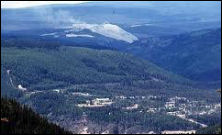Main Listing Page
Some Canadian Mining History
British Columbia has been one of the world's major mining regions since the mid-1800s and to this day is a key international player. Encompassing the largest part of the Canadian Cordillera, a mountain belt rich in minerals and coal, B.C. produces and exports a significant amount of copper, gold, silver, lead, zinc, molybdenum, coal and industrial minerals every year. Historically, B.C.'s vast mineral resources have contributed extensively to the province's growth and development. The Hudson's Bay Company first started producing coal on Vancouver Island in the 1840s, and the discovery of gold along the Fraser River in the 1850s sparked a major gold rush, which was ultimately responsible for the settlement of many parts of that region. As B.C.'s population increased, the provincial infrastructure improved, and miners were able to explore more and more of the province's terrain, leading to many new mineral deposit discoveries.
Throughout the century following the Fraser River Gold Rush, most mining activities in British Columbia took place underground. But in the early 1960s, the feasibility of open-pit production increased tremendously, and as a result, several huge copper mines opened, including Highland Valley Copper—the largest open-pit operation in all of North America.
Apart from casual observations made during early marine explorations along our coast, such as those of Cook and Bodega y Quadra in the latter part of the 18th century, the first specifically geoscientific observations recorded in the Canadian Cordillera were those of Alexander Mackenzie. During his return trip in 1789 up the river that bears his name, near the modern community of Fort Norman he noted several smokes along the shore and experienced a very sulphurous smell and at length discovered that the whole bank was on fire for a very considerable distance. He concluded that it proved to be a coal mine, to which the fire had communicated from an old indian encampment. Some 36 years later, John Richardson in the company of John Franklin’s second overland expedition to the polar sea, recorded observations at the same locality and noted The pipe-clay, when taken newly from the bed, is soft and plastic, has little grittiness, and when chewed for a little time, a somewhat unctuous but not unpleasant taste. The locality comprises a series of bocannes within Early Tertiary alluvial fan deposits that include lignite and pyroclastics. Serious geological observations began in 1857 when James Hector, a physician and naturalist attached to the first CPR route expedition led by Captain John Palliser, made observations on the stratigraphy of the southern Rockies and recorded the first observations of coal deposits on Vancouver Island.
Comprehensive studies of the Cordillera began in the 1880s by Dawson and McConnell. A far-ranging reconnaissance journey by these two men in 1887 and 1888 provided the initial geological information on the northern Cordillera, including much of northern British Columbia and the Yukon where the respect and affection of the people for George Dawson is expressed in the name of one of its most important communities.
Here is a paraphrase from the opening paragraph of a recently published book (Yorath, 1991).
The people of the Cordillera are my heroes. Collectively they form a cult. Their language is expressed in contractions, is often metaphoric, and, to the uninitiated, utterly unintelligible. Their altars are rocks, their season is summer and their children tend to have birthdays in June. What distinguishes them from most others is their consuming passion for what they do. They long for summer when the mountains will ring with the blows of their hammers, when helicopters will carry them through the sky. They will gaze from windswept peaks and see continents in collision, entire oceans created and destroyed. They will lose themselves in time.




